![occasionalbanner300[1]](https://ymlp.com/https.php?id=purewatergazette.net/blog/wp-content/uploads/2013/04/occasionalbanner3001.gif)
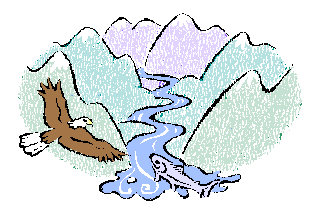
The Pure Water Occasional for March 28, 2016
In this Easter-time Occasional, you'll read about Katalox Light, microSieverts, the Pawnee Plunge, Smithson's Spiral Jetty, and the Gandhi of water. Learn why cats hate water, how much Nestle pays for water is sucks out of federal lands, why ScaleNet is now One Step, and how dairy cows in Saudi Arabia manage to drink California water. Pentair's new GRO membrane, the world's hand pump dilemma, vanishing lakes, water scarcity in India, a strange accident at Lake Waco, and the thirstiest fiber. Learn how to remove arsenic from drinking water, hear Pure Water Annie discuss the importance of dissolved oxygen, ponder the possibility that it's our unwillingness to pay taxes that makes chlorination of our tap water necessary, and, as always, there is much, much more.
To read this issue on the Pure Water Gazette's website, please go here. (Recommended! When you read online you get the added advantage of the Gazette's sidebar feed of the very latest world water news.)
You'll sing better.

Why Do We Have to Have Chlorine in our Municipal Water? The Answer Is Not as Simple as You Think.
Disinfecting tap water with chlorine is the norm around the world and we've been doing it so long in the United States that we accept it as an essential though sometimes unpleasant fact of life. You may not know that some very advanced countries get along well without chlorinating their water.
Although we complain about the taste of chlorine and we're understood for some time that it certainly has some negative health implications, we have been trained to view it as a necessary evil. After all, the chlorination of water virtually wiped out water-borne diseases like Typhoid. Without chlorination, we would go back to the age of cholera, right?
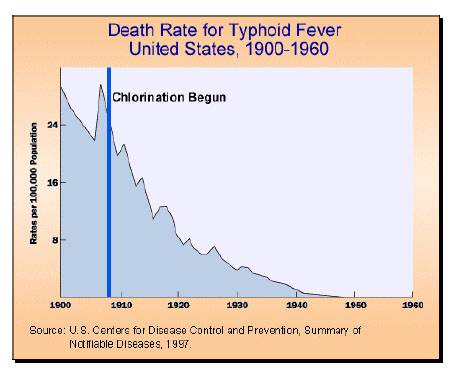
Distributing tap water with residual chlorine is a century-old strategy used to protect populations by preventing the proliferation of waterborne pathogens. But is it necessary? In a recent commentary published in the journal Science, researchers provide evidence from Europe showing that chlorine could be forgone if other protective barriers are in place.
Factors other than the addition of disinfectants determine the quality of tap water. Certainly, the quality of the source of the drinking water is of utmost importance, as is the treatment of the water before its delivery into the distribution network. What is often not considered, though, is the extreme importance of the quality of the distribution network itself. Decades of experience in the Netherlands, Germany, Austria, and Switzerland have shown that, when none of these three elements are compromised, the number of waterborne-disease outbreaks are low, even lower than in countries that add chemical disinfectants to their water supply in order to compensate for poorly maintained networks, insufficient water treatment, or contaminated water sources.
But the researchers point out that distributing the water without added chlorine comes at a cost. It requires protecting groundwater sources, properly controlled water treatment, and regular maintenance of the water distribution network. But where chlorine can be foregone, the benefits go beyond improving the taste of tap water. When disinfectants, like chlorine react with natural organic matter that is always present in drinking water, this can lead to the formation of disinfection by-products, some of which are potential carcinogens.
In the United States, failure to support water infrastructure has resulted from misguided efforts to keep taxes and water rates that support water infrastructure ridiculously low. Failure to maintain the sources, treatment plants, and the distribution systems have led to reliance on the cheap fix of dosing our public water with chlorine. It keeps us safe from cholera, but it keeps us from enjoying the really excellent public water available to more advanced societies.
Reference: NewsMediaCom
Gazette Famous Water Pictures: Smithson's Spiral Jetty
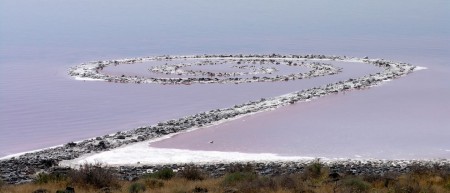
Robert Smithson's "Spiral Jetty" land art sculpture in Utah's Great Salt Lake.
The most famous work of American art that almost nobody has ever seen in the flesh is Robert Smithson's ''Spiral Jetty''--6,650 tons of black basalt and earth in the shape of a gigantic coil, 1,500 feet long, projecting into the remote shallows of the Great Salt Lake in Utah, where the water is rose red from algae.--NY Times.
In 1970, when artist Robert Smithson executed his famous "earthwork" that extends into the Great Salt Lake, the lake's water level was exceptionally low because of a severe drought. The work cannot be seen when the lake's water is at normal levels.
As New York Times Magazine explains, "Smithson anticipated that the lake would rise and fall, the residue of salt crystals causing the black rocks to glisten white whenever the water level dropped. But he miscalculated. Spiral Jetty was visible for about two years, then became submerged and stayed that way except for a few brief reappearances."
Because of that minor miscalculation, the only time you can see "Spiral Jetty" peeking above the water is when the levels are below 4,195 feet. This is likely to happen during a drought (like the one that occurred during the initial building of the Jetty), but in recent years, water levels have been dipping below the historic average (4,200 feet) more often than usual, likely as a result of what many scientists speculate are man-made influences.
The Spiral Jetty from the air.
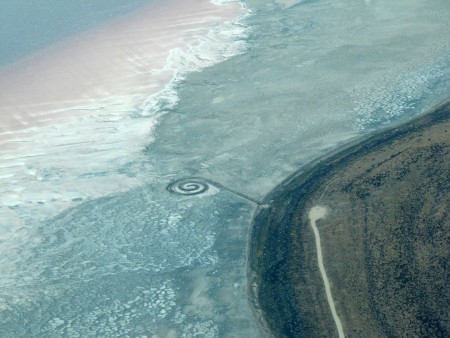
If you are the largest dairy producer in Saudi Arabia and you are running out of water to grow cattle feed, there’s only one thing to do if you want to stay in business: go shopping.
Which is exactly what dairy giant Almarai has done, undertaking a global search for land and water to grow alfalfa to feed its dairy cows. The search brought Almarai to a most surprising place: California, which is suffering its worst drought in recorded history.
Earlier this year, the company announced that it had paid $31.8m for 1,790 acres of land near Blythe, in the southeastern corner of California, for the sole purpose of growing alfalfa. Known as lucerne in some parts of the world, alfalfa is a member of the pea family, growing up to 1 meter high with small purple flowers and leaves that resemble clover. Almarai will grow the crop using water diverted from the Colorado River, then ship it back to Saudi Arabia to feed Almarai’s estimated 1m dairy cows, helping to ensure it remains the number one dairy producer in a nation of 30 million people.
But for Adam Keats, a senior attorney at the advocacy group Center for Food Safety, Almarai’s land purchase highlights everything that’s wrong with globalization. Not only does it result in exporting California water in the form of alfalfa, he said, but it also creates enormous carbon emissions to transport heavy, bulky animal feed to the other side of the world.
“Water is an essential and core common good,” Keatsa said. “But they have figured out this proxy method of owning our shared water resources. It’s a fiction to believe that globalization is this unqualified good thing for the world.” Read the rest on the Pure Water Gazette website.
World Water News
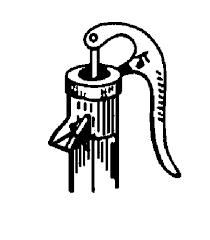
Over the past few decades, the humble hand pump has become the go-to option for rural water supply in developing countries. They’re used to extract groundwater which is mostly clean, easy and cheap to access, and available year-round. Hand pumps are usually a better option than open wells – which are highly vulnerable to contamination – and piped systems or motor-driven pumps, which require the skills, finances, and management that’s often lacking in remote, rural areas.
However, though around 60,000 hand pumps are installed across sub-Saharan Africa every year, typically 30 to 40% of those in the region do not work at any one time. Read The Guardian's analysis of the dilemma of the broken pumps.
Incoming Stanford freshman Makenzie Fischer scored six goals as the U.S. women's water polo team routed France 19-0 to earn a berth to the Rio Games at the Olympic qualification tournament in the Netherlands.
There is a serious drought going on in Africa and almost no one is talking about it.
The world's poorest pay largest percentage of income for water, study says. According to a WaterAid study, water saps more than half of the meager earnings of many of the world’s poorest while those in developed nations spend only a fraction of their incomes on water.
Think about it: if people in underdeveloped communities did not have to walk several hours just to get water for their households, they could instead spend those hours learning and earning.
A Waco, TX woman survived a 60 foot fall into Lake Waco and a 150 yard swim to shore after her pickup split apart following a one-vehicle accident on a bridge. Details.
A new study finds that India leads the world in number of citizens without access to clean water.
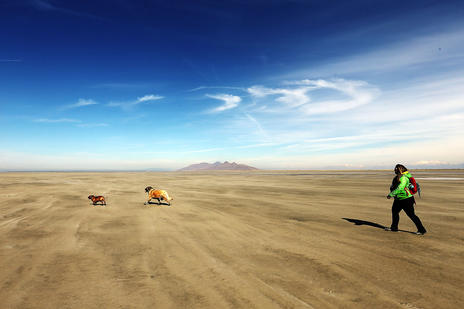
Is the Great Salt Lake turning to dust? Read this excellent article from the Desert News.
Many of world’s lakes are vanishing and some may be gone forever. Bolivia’s second largest lake has vanished into thin air. In December, Lake Poopó became a dry salt pan and its largest lake – Lake Titicaca – is heading towards trouble, too. Recent research and new data suggest that lakes in other parts of the world may also be on their way out.
Multi-National Giant Nestles Gets California Water Almost Free
Nestle Waters North America — a subsidiary of the Swiss multinational food giant and the largest bottled water company in the nation — has been drawing 25 million gallons of water a year from mountains springs under a permit that expired some three decades ago. The company pays the government a modest permit fee of about $500 a year and markets the product as Arrowhead brand spring water. Details.

If you've wondered why cats hate water, this article will explain.

India's Water Man Uses Local Action Methods of Gandhi
Rajendra Singh, known as the Gandhi of Water, has pioneered community-based efforts in traditional water-harvesting and management techniques in India's Rajasthan state, among the driest places on the planet, where mercury peaks to 50 degrees Celsius. Full article.
Have you wondered why no one will go to jail for the lead contamination of Flint, Michigan's water? Read The Crimes Behind the US Lead Water Crisis.
According to a news story that sounds like the plot from a cheap adventure movie, a man and child were rescued from a scary adventure in the closed Pawnee Plunge Water Park in Columbus, NE.

Cotton: The most popular and the thirstiest fiber.
Cotton is a particularly thirsty fiber. The production of just one pair of jeans devours around 10,000 liters (2,650 gallons) of water. A UNESCO report found that around 80 percent of that water is used for the cultivation of cotton. Meanwhile, a study conducted by the British government's Department for Environment, Food and Rural Affairs concluded: "Cotton is the most water demanding fiber, outstripping the water demands of all other fibers."
Read "The Search for Sustainable Fashions" in Spiegel Online International.
Radiation Exposure from Water
The following is excerpted from a Las Vegas Sun article. The obvious conclusion is that water isn't a big worry when it comes to total exposure to radiation. A µSv is a microSievert, a measurement of radiation.
How much radiation am I exposed to in ...
• .1 µSv* = Eating one banana
• ~1 µSv = Drinking tap water for a year
• 40 µSv = Flying from New York City to Los Angeles
• 250 µSv = Annual EPA emission limit for nuclear power plants
• 400 µSv = One mammogram
• 10,000 µSv = One full-body CT scan
• 36,000 µSv = Chain smoking for a year
• 100,000 µSv = Yearly amount linked to an increased risk of cancer
• 1,000,000 µSv = Acute dose causing temporary radiation sickness
• 10,000,000 µSv = Fatal dose; death within weeks
• 20,000,000 µSv = Fatal dose; death within days
• 50,000,000 µSv = Ten minutes next to the Chernobyl reactor during the meltdown.
From the Las Vegas Sun.
How to Remove Arsenic from Water
There are many treatment strategies that can be used to reduce arsenic in water. A Water Conditioning and Purification article (paper issue, Dec. 2013) listed the following as effective arsenic treatments:
1. Activated Alumina
2. Coagulation-assisted filtration
3. Electrodeionization
4. Granular ferric hydroxide
5. Ion exchange
6. Lime softening
7. Nanofiltration
8. Reverse osmosis.
Of these, three are by far most commonly used for residential treatment: Activated Alumina, Granular Ferric Hydroxide, and Reverse Osmosis.
This is not to suggest that a home owner can simply get a reverse osmosis unit or an activated alumina filter and assume he has solved the arsenic problem. Arsenic is potentially life-threatening and it should not be taken lightly. Treating arsenic is actually a fairly complicated, although the basics that you need to consider are these:
In water, arsenic exists as arsenite (As III) or arsenate (As V). The most common is As(V). Usually if water contains dissolved oxygen and the pH is 7 or above As(III) will naturally be oxidized to As(V).
Common treatment methods like reverse osmosis, activated alumina, and ferric hydroxide filtration remove As V well but not As III. Therefore, the usual practice is to use an oxidizer in front of the treatment process to assure that the Arsenic in the water exists as arsenate. Of the commonly used oxidizers, chlorine, potassium permanganate and ozone work very well. Also useful is filtration through Filox, which has proven to be an effective oxidizer for Arsenic.
More detailed information on this topic can be found on the Pure Water Occasional website.
New from Pure Water Products
After lengthy preparation, the new shopping cart for our main website is now in operation. Please order something to try it out. The cart, as well as our websites, are done "in house" by the same people who answer the phones, package products, and respond to customer emails. The main Pure Water Products website (www.purewaterproducts.com) is one of the world wide web's richest sources of water treatment information. We're proud of it.
We're now offering the new Pentair GRO encapsulated RO membrane as an option on our Black and White RO units. The 50% recovery membrane is a major water saver. We offer the 50 gallon per day version only. We can also help you retrofit most existing RO units to run the GRO. Although it's slightly longer than most conventional membrane housings, it fits regular housing clips. If your RO unit is a conventional build, like our Black and White in the picture below, converting to GRO is easy.
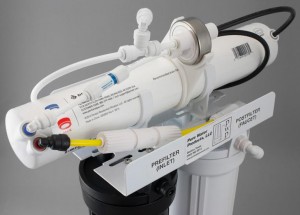
The Pentair GRO 50% recovery membrane installed on our Black and White 3-Stage unit.
Watts ScaleNet, the salt-free softener alternative featuring template assisted crystallization, has been replaced by an identical product called One Step. Identical as in exactly the same. Watts has marketed the product for some time under two brand names and is simply combining the two into one. We'll still have all replacement parts and media for ScaleNet units. We're told that wholesale prices will go up, but have no immediate plans to raise our website prices on either the units or the media . One Step's main competitor is Filtersorb, by the way, and we have it, too, although it isn't on our websites. Pricing is essentially the same, and parts like tanks and heads interchange between Filtersorb and One Step units. Only the media is different. If you'd like Filtersorb information, please call.
Another upcoming product change involves our most popular filter cartridges, MatriKX carbon blocks. KX Industries, a New Jersey company, has acquired Filtrex (another carbon block line that we sell) and the combined companies will be moving to India later this year. So, if you want to stock up on MatriKX made-in-USA blocks, now is the time.
Katalox Light, the German-made iron/sulfide medium, continues to grow in popularity and now constitutes a large part of our iron/H2S backwashing filter sales. More about Katalox.
In addition to AerMax units and our Single Tank Aerators, we now stock a complete economy passive aeration system with venturi, aeration tank, and all needed accessories. See below:
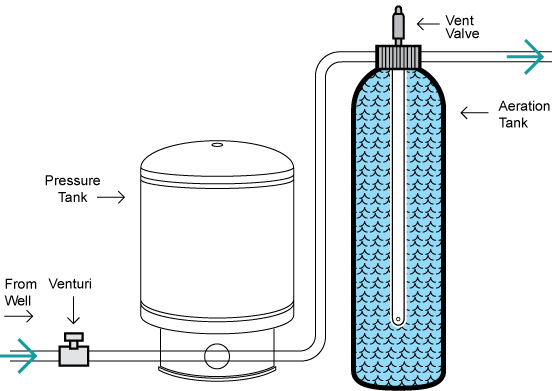
In the passive venturi aeration system pictured above, when the well pump is running, water from the well passes through the venturi valve which draws air into the water line. An aeration tank which follows the well's regular pressure tank provides contact time and mixing space so that the air can oxidize the iron, manganese, or hydrogen sulfide for removal by a filter. (The filter is not shown and is not included in this product. We provide many excellent filters for this purpose on our main website.) The vent valve on top of the aeration tank vents off excess air.
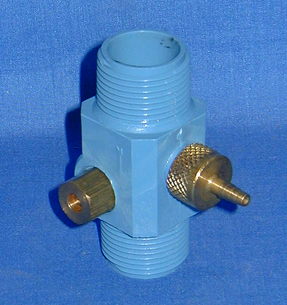
Waterite Venturi Air Injector. Air is drawn into the water stream through the stem on the right. The nut on the left provides an adjustment.
Dissolved Oxygen: An important Constituent of Water

by Pure Water Annie
Gazette Technical Wizard Pure Water Annie Shines Light on Another of Life's Perplexing Questions, Explaining How Oxygen Gets Into Water and Why It Needs to Be There
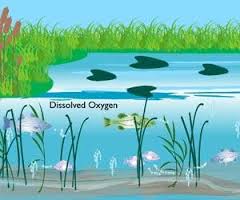
Our atmosphere consists of around 21 percent oxygen. Water, however, has only a fraction of 1 percent.
Oxygen dissolves into water at the point where water and air meet.
Dissolved oxygen, called DO, is made up of microscopic bubbles of oxygen gas in water. This dissolved oxygen is critical for the support of plant life and fish.
According to one authority, "DO is produced by diffusion from the atmosphere, aeration of the water as it passes over falls and rapids, and as a waste product of photosynthesis. It is affected by temperature, salinity, atmospheric pressure, and oxygen demand from aquatic plants and animals."
Dissolved oxygen is measured as percent saturation or as parts per million (ppm) or milligrams per liter (mg/L). As the chart below indicates, oxygen dissolves easily into cold water, not so easily into warm, and not at all into boiling water.
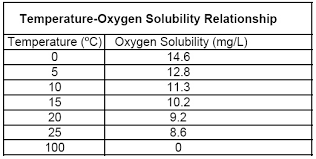
In water treatment, a high level of dissolved oxygen can make water taste better, but it can also make water corrosive to metal pipes. Dissolved oxygen is a necessary ingredient of many water treatment processes. The use of catalytic carbon to remove iron, for example, requires a minimum of about 4.0 ppm of dissolved oxygen in the source water, and Birm, the popular iron removal medium, will not work without sufficient dissolved oxygen.
Oxygen can be added to water by simple aeration techniques which involve exposing the water to air. Ozone is also used in water treatment to greatly increase the oxygen content of water.
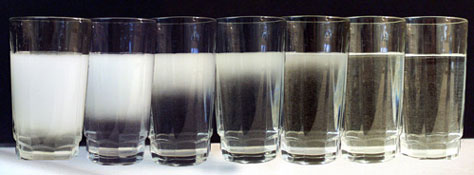
Glasses show how oxygen leaves water. Milky water on left with high level of dissolved oxygen. On the right, the air has gone back to the atmosphere and the water is clear. Often a film will be left at the surface or "skin" at the top surface of the water. When cloudy water clears from bottom to top. the discoloration is harmless air. Water cloudy from silt clears from top to bottom and leaves residue at the bottom of the glass.

Please visit our RO Parts Page for tanks and accessories. We also have dedicated parts pages for countertop water filters, undersink filters, and aeration equipment. We stock parts for everything we sell.
Thank you for reading. Please come back next week.
Places to Visit on Our Websites:
Garden Hose Filters. Don’t be the last on your block to own one. And don't forget that National Garden Hose Day is just around the corner.
Model 77: “The World’s Greatest $77 Water Filter”
”Sprite Shower Filters: You’ll Sing Better!”
An Alphabetical Index to Water Treatment Products
Our famous whole house Chloramine Catcher
Single Tank Aerators for Iron and Hydrogen Sulfide
Pure Water Occasional Archive: Sept. 2009-April 2013.
Pure Water Occasional Archive: April 2013 to present.
Write to the Gazette or the Occasional: pwp@purewaterproducts.com
Fair Use Statement
Please Visit
The Pure Water Gazette – now with an up-to-the-minute feed of the latest water news.
The Pure Water Occasional
Pure Water Products
![occasionalbanner300[1]](https://ymlp.com/https.php?id=purewatergazette.net/blog/wp-content/uploads/2013/04/occasionalbanner3001.gif)


















